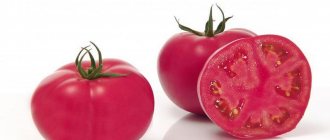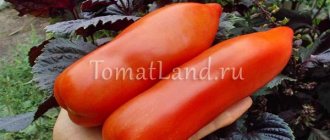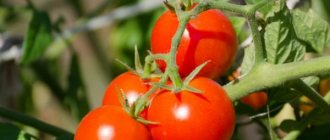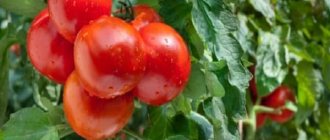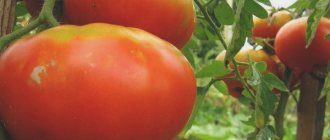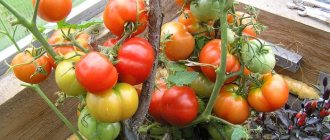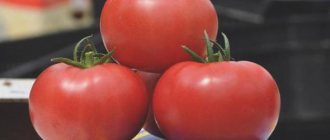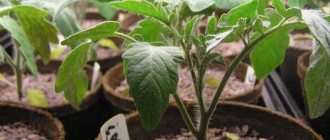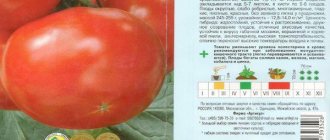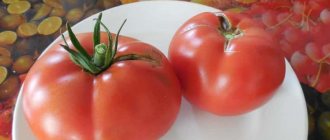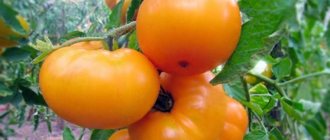Where does a good tomato harvest begin? Of course, from a productive variety, which includes Fitous. Created in 1997, it has long been widely sold, and has become a leader in the mid-early group. It is valued for its abundance of harvests and excellent product and taste qualities.
| Height | Landing location | Ripening time | Fruit color | Fruit size | Origin | Fruit shape |
| Tall | Greenhouse, Open ground | Mid-early | Reds | Average | Variety | Plum-shaped or oval |
Characteristics of tomato and its fruits
Of course, if this variety is so popular and does not lose its “position” for many years, then one can understand that it has many more advantages than disadvantages. Let's take a closer look at them.
pros
The main advantage of this variety is the ability to grow in open areas. Other advantages include:
- Demidov's endurance. The bushes develop quickly and actively form ovaries, which results in a bountiful harvest in the form of large fruits. And all this with minimal planting care;
- Easy to care for. It is caused by a small number of branches and short stature of the plant with its further “thickening”;
- Resistance to diseases and pests. Bushes of the Demidov variety are practically not susceptible to the negative influence of various harmful insects, viruses and other parasites;
- High yield. The variety is used for cultivation not only by gardeners, but also by large enterprises for commercial purposes. From 1 ha. you can get from 150 to 400 hundredweight;
- Attractive appearance. Due to its resistance to mechanical stress, almost 97% of the entire crop has a “marketable appearance”;
- Possibility of harvesting without waiting for the fruit to fully ripen. Necessary for further ripening of fruits;
- "Tomato taste." As well as the juiciness and pronounced sweetness of the fruit.
Minuses
Alas, if you do not follow all the rules for watering the plant, this can lead to cracking of the fruit. Tomato skins can burst when, during a severe drought, the plants are watered too often and they take on excessive amounts of moisture.
If the rainy season does not drag on, the moisture is evenly distributed among all the fruits and the skin is not damaged.
The second disadvantage is the risk of getting rotten fruits due to unsystematic watering of plants. During drought, plant roots cannot release the necessary amount of substances to nourish the plant. As a result, the leaves become dry.
The outflow of moisture from the top of the plant to the roots begins, due to which some Demidov cells die, the fruit becomes softened, and begins to rot. Then fungal infections appear on it.
Of course, these “disadvantages” are inherent in almost all tomatoes, and fruit-bearing plants in general.
Description of the Fitous tomato, cultivation and planting rules
The Fitous tomato is grown in greenhouses and also in open ground. The variety, bred 20 years ago, is still very popular among summer residents due to its unpretentiousness and resistance to various diseases.
What is a Fitous tomato?
Tomato bushes can grow to a height of half a meter, have a powerful stem and ripen in 110 days. From 4 to 6 fruits grow in the brush of a tomato bush.
Description of the variety and characteristics:
- fruits are red and oval in shape;
- the weight of 1 tomato can reach 70 g;
- a tomato has 2-3 chambers;
- The density of the tomato is high, the skin is not hard, but does not crack;
- transportability and taste properties are excellent;
- Tomatoes can be stored for a long time.
Planting tomatoes and care
Fitous is grown using the seedling method. Sowing of seeds begins in the last days of March or early April. The period depends on the region where the landing takes place. Seeds are planted to a depth of no more than 1 cm. Pinching and staking are not required for this variety.
Watering tomatoes should be done after sunset. Warm water is used for irrigation. To increase productivity, tomatoes need to be fed. For the first time, fertilizing should be done a couple of weeks after planting the tomatoes in place. Next time, fertilizing is carried out immediately before the bushes flower. The tomatoes should be fed the third time when they begin to ripen.
One of the most important characteristics is that tomatoes are blight-resistant. In addition, the variety is resistant to other types of diseases to which tomato bushes are usually exposed.
Features of cultivation and storage
Planting on beds is carried out when the bushes reach the age of 50-55 days.
Holes are dug 30 cm deep. In each hole add:
- 10 g of superphosphate;
- 1 tbsp. wood ash;
- 5 g potassium sulfate.
Maintain a distance of 40-50 cm between bushes. Fix tall shoots to a support. They grow bushes with 2-3 trunks.
Ripe tomatoes can be stored for up to 3-4 weeks. Use dark, cool closets, rooms, and basements for storage.
Tomato Fitous - description and characteristics of the variety
The Fitous tomato variety was bred by breeders back in 1997, but even today it enjoys well-deserved popularity due to its many positive qualities. It belongs to the mid-early variety, and feels equally good both in the greenhouse and in the open air.
Fitous variety - basic information
As noted above, tomato is very popular among gardeners. The variety has been cultivated for several decades, and reviews about it are only positive. Thus, Fitous is well resistant to most diseases that affect tomatoes.
The variety is determinate, the height of the bushes rarely exceeds 50 cm. The stem is thick, powerful, the inflorescence is simple. There can be from 4 to 6 or more tomatoes in one brush. From the moment the first seedlings appear until harvest, approximately 90-110 days pass, depending on the weather, growing conditions, etc.
A ripe tomato is red in color, oval in shape, the tomatoes weigh a little - from 50 to 70 grams. Inside the fruit there are 2-3 chambers with seed material. The fruits are dense, strong, with tough skin and do not crack. They tolerate long-term transportation well and are stored for a long time.
How to properly plant seeds and care for plants
Tomato can be propagated using seedlings. The seeds are planted in the ground quite late - at the end of March, early or mid-April (depending on the climate). The seeds are buried shallowly - about 1 cm.
Bushes of the Fitous variety do not need staking or pinching. The distance between bushes should not be less than 50 cm. That is, 3 bushes should be placed on one square meter. For tomatoes, slightly acidic, well-moistened soil is most preferable. A little superphosphate won’t hurt – about 10 grams. per bush (applied when planting in a hole).
You can’t water tomatoes in hot weather; it’s best to do it in the evening, after sunset. It is highly advisable to use warm water for irrigation. The bushes need to be fed periodically. The first feeding is carried out 14 days after planting the seedlings in the ground. The second time is applied before flowering, the third time before the fruit begins to ripen.
Of course, you should not neglect the simplest agricultural techniques in the form of weeding and periodically loosening the soil between the bushes.
Diseases of the Fitous variety
The variety is resistant to most diseases, especially late blight. It is not susceptible to other diseases common among tomatoes. If the bushes have been attacked by pests, you should immediately take action and treat the plants with special means. Treatment with chemicals can only be done if the plant is not yet bearing fruit; otherwise, only folk remedies are used to prevent chemicals from getting on the vegetables.
Productivity, use of ripe fruits
The variety bears fruit well. If agricultural practices are carried out correctly and all conditions for cultivation and care are observed, small plants will delight the gardener with luxurious bunches of fruit.
Ripe tomatoes can be used in different ways: canned whole, eaten fresh, prepared in salads, pasta and homemade ketchup.
Pros and cons of the variety
It is customary for gardeners to analyze any variety from the positive and negative sides. So, the advantages of Fitous should be highlighted:
- Abundant harvest.
- Good resistance to most diseases.
- The litter does not require special care and is quite unpretentious.
- Ripe tomatoes are shelf-stable, do not crack, withstand long-term transportation well, and retain their presentation for a long time.
- There is no need to form stems; the plant should develop freely.
As for the shortcomings that need to be mentioned, none have been identified at the moment.
Elena Smirnova, 33 years old:
Based on real reviews and the opinion of experienced gardeners, a beginner in this business will be able to better understand the intricacies of growing tomatoes: applying fertilizing and fertilizers, growing seedlings, caring for bushes, picking, etc.
Serezha, 27 years old:
Phytous grows in my garden beds. All fruits ripen, even the smallest ones. Well preserved, very pleased with the variety.
Mila, 34 years old:
I have been growing this variety in my summer cottage for several years now. I collected a good harvest from several bushes, prepared seeds for the next season, and will definitely grow Fitous again.
Lera S., 40 years old:
For the third year in a row, Fitous has been the main tomato variety in my garden beds. The variety fully complies with its characteristics indicated by the manufacturer. The harvest is very good, the tomatoes are even larger and heavier than in the description. The plants did not dive, did not form stems. Canned tomatoes taste excellent! I recommend it to everyone!
As is clear from the reviews, summer residents prefer this variety because of its good yield, unpretentiousness and resistance to most diseases.
The best varieties of tomatoes for 2021: photos and descriptions
When choosing tomatoes for their plot, gardeners, first of all, rely on varietal or hybrid characteristics. Productivity is the most important criterion on which the quantity and quality of the harvest depends. Sometimes it can be difficult to choose the right option from the rich variety of tomatoes for open ground and greenhouses. Then varieties are selected depending on the growing region, ripening period, degree of disease resistance and other factors.
A huge number of species with excellent yields are intended for growing vegetables in the open air. Low-growing bushes with large fruits are one of the advantages of tomatoes for the soil. Such heat-loving plants are easier to care for and do not require complex agricultural practices.
According to ripening period
Tomatoes, like other vegetable crops, are characterized by different ripening periods, from early to late.
| Ripening period | Ripening of fruits after the appearance of the first shoots | general characteristics | The most productive tomatoes (2020) |
| Ultra-early ripening | On day 80-85 | The fruits are small, juicy, and low in sugar. The height of the bush is no more than 50 cm. Not suitable for preservation. | Little Red Riding Hood, Pride of Russia, Benito, Superstar, Valentina, Marisha, Maksimka |
| Early ripening | For 90-95 days | Small, delicate fruits, average yield. Suitable for canning and salads. Bushes grow up to 70 cm | Agatha, Riddle, Augustine, Lyana, Sanka, Buyan, Lakomka, Amur standard, Grandmother's kiss |
| Mid-early | On days 100-103 | The fruits are juicy, small, aromatic. The purpose is universal. Bush shape - compact | Openwork, Babushkino, Pulka, Red Giant, Russian Soul, Cardinal, Flamingo |
| Mid-season | On day 100-115 | High taste, excellent yield. There are both low-growing and tall varieties | Scarlet Candles, Hybrid Basket, Stresa, Intuition, Black Baron, Pudovik, Pink Honey |
| Late ripening | On day 120-130 | Excellent fruit taste, high yield, universal purpose. Good keeping quality and transportability of fruits | Giraffe, Cosmonaut Volkov, Titan, Rio Grande, Russian size, King of Kings, Rocket, Premier |
The ripening time, color and shape of tomatoes depends on the variety.
Usually early-ripening vegetables with not large fruits and not a large harvest, but with a quick, friendly yield of ripe tomatoes. Mid-season ones also have medium sizes. Late ones are usually difficult to care for, but it is among them that you can find champions in weight, but there are not many such beauties on the bush.
Every year, breeders create new species with high quality indicators. In stores you can buy specialized varieties of tomatoes designed for growing in certain climatic conditions. Classification by regions of Russia:
- for the Moscow region: Champion, Sweet Bunch, Honey, Pink Elephant, Fireworks, Bull's forehead;
- for the southern regions: Torch, Novice, Titan, Winner, Bison, Ermak, Gift, Mikado;
- for the middle zone: Bull's Heart, Black Prince, Uzbek (Yusupov), Moskvichka, Snowdrop, Big Brother, Spasskaya Tower;
- for Siberia: Siberian heavyweight, Ultra early ripening, Sanka, Abakan pink;
- for the Urals: Coin, Bull's Heart, Button, Countryman, Yellow Buyan, Bullfinch, Demidov;
- for the far north: Snowy Tale, Ballerina, Ladyfingers, Berdsky Large, Countryman, Oak, Gina.
An unpredictable, cold or, conversely, excessively warm climate is not a reason to refuse to grow tomatoes in open ground. Thanks to selection, varieties have been developed that grow and develop well in any terrain.
To obtain a rich harvest, you need to choose tomato varieties not only with the appropriate characteristics. It is necessary that this criterion be supplemented by such an indicator as disease resistance.
READ MORE: Bashkir beauty apple tree description and characteristics of the variety, cultivation with photos
Late blight, root rot, tobacco mosaic, cladosporiosis are diseases that most often affect plantings of heat-loving crops.
A catalog of tomatoes that can withstand the onslaught of various diseases:
- Blitz;
- Koenigsberg;
- Geisha;
- Betta,
- Anyuta;
- Bohemia;
- Chio-chio-san;
- Tatiana;
- Puzata hut;
- Lights of Moscow;
- Yablonka Russia;
- Crimson giant.
Unfortunately, there are no varieties that are 100% resistant to infections. But there are hybrids that produce a harvest until the active phase of many fungal diseases and infections begins.
Having a good greenhouse at your disposal, you can get fresh tomatoes to your table all year round. Greenhouse varieties are suitable for preparing salads or canning. Excellent salad tomatoes can be obtained from the following varieties:
- Geisha;
- Fairy gift;
- Andromeda;
- Eagle beak;
- Pink Angel;
- Pink Pearl;
- Fatalist;
- Scarlet caravel;
- Amana orange
The best varieties for preservation:
- Auria;
- Banana legs;
- Pink raisins;
- Rajah;
- Baba;
- Alexander the Great.
Cherries are sweet, small tomatoes that grow well both outdoors and in a greenhouse, but small-fruited vegetables tend to be more productive in protected beds. Magic Harp F1 and Yellow Caramel F1 are hybrids whose fruit weight does not exceed 25 g.
When choosing a vegetable for a greenhouse, many rightly give preference to tall and high-yielding varieties. But low-growing plants, which usually have an early ripening period, as well as mid-ripening tomatoes, are also excellent for polycarbonate shelters in all regions of Russia.
For open ground, breeders also offer species with high yields of hybrid origin; they are resistant to diseases and temperature changes. The best tomato varieties of 2020:
- Intuition F1 is one of the best tomato hybrids for picking with trusses, mid-season, from germination to harvesting the first vegetables - 110 days.
- Katya F1 is an early ripening hybrid. The fruits weigh 90-130 g and ripen simultaneously. From 1 m² you can harvest more than 10 kg of fruit per season.
- Search F1 – unpretentious and at the same time tasty tomatoes. The hybrid withstands cold weather and is immune to most diseases. The bushes are strewn with small red fruits, which are excellent for pickling and canning.
- Blagovest F1 is an early-ripening hybrid. The fruits are round, glossy, with slightly pronounced ribbing. From one bush you can collect up to 5 kg of fruit.
- La la fa F1 - has excellent consumer qualities, high yield and unpretentiousness. The average weight of the fruit is 140-170 g. From 1 m² you can harvest up to 20 kg.
- Vladimir F1 - has a high yield and is suitable for cultivation in any type of soil. High productivity throughout the entire fruiting period.
- Beef King F1 is an early maturing Dutch hybrid. The tomatoes are round, dense, smooth. From one bush you can collect up to 4-5 kg. Resistant to low temperatures and diseases.
- Ashdod F1 – tomatoes with smooth, dense skin. Fruit weight is from 110 to 140 g. The pulp has a bright burgundy color.
- Tanya F1 is a hybrid from the Netherlands with excellent immunity, dense structure, and good yield. The fruits have a regular round shape, weighing 150-200 g. They tolerate transportation well.
If the designation on a bag of planting material is F1 – hybrids of tomatoes (or other plants) of the first generation, F2 – of the second, and so on.
Exceptional taste, fruit weight, constant yield, disease resistance, adaptation to weather conditions are the advantages of hybrids over tomato varieties.
Reviews
My favorite tomato variety in 2021 is Idol, medium-sized, very tasty, productive. I planted seedlings on March 20, the first fruit was picked on June 20. The bushes bear fruit for 3 months. The most successful cherry variety is Black Cherry, very tasty and productive, the most favorite tomato of children.
I like the fruits to be large and regular in shape. Therefore, I prefer the varieties Early Rose, Peach, Heavyweight of Siberia and Pink Fig. This year I raised Grandma's Secret. The bush is determinate, the average height is 180 cm. I have never produced kilogram fruits, the maximum weight is 700-800 g. Probably this is because I allow the bush to form into two or three stems.
READ MORE: Multi-tiered onions, planting, growing and care with photos and videos
I never conduct systematic analysis. I analyze when the tomatoes are already picked. I love large, sugary berries. I really like the Pink Giant in taste, but the yield is low. So far, my requirements are relatively met by 2 varieties - Pink Andromeda and Mazarin. Over time (I’m a novice gardener) I’m thinking of finding the optimal variety or hybrid of tomatoes.
Now I mainly grow tomatoes in my dacha. About 20 different varieties. Red, yellow, brown, black. Beauty! Cherry, Cream, Ox heart. Different sizes, different tastes, different ripening periods - from May to October. The main thing is that the weather is warm. I’m not keen on canning, so we use fresh vegetables. If the harvest is good, I give the remaining tomatoes to relatives.
Stability of the harvest from year to year, the ability to adapt to weather conditions, resistance to pests and diseases are important criteria for a reliable tomato variety. In 2021, you can plant both time-tested tomatoes and new elite varieties. The choice depends only on the preferences of gardeners.
Description of the Fitous tomato, cultivation and planting rules
The Fitous tomato is grown in greenhouses and also in open ground. The variety, bred 20 years ago, is still very popular among summer residents due to its unpretentiousness and resistance to various diseases.
What is a Fitous tomato?
Tomato bushes can grow to a height of half a meter, have a powerful stem and ripen in 110 days. From 4 to 6 fruits grow in the brush of a tomato bush.
Description of the variety and characteristics:
- fruits are red and oval in shape;
- the weight of 1 tomato can reach 70 g;
- a tomato has 2-3 chambers;
- The density of the tomato is high, the skin is not hard, but does not crack;
- transportability and taste properties are excellent;
- Tomatoes can be stored for a long time.
Planting tomatoes and care
Fitous is grown using the seedling method. Sowing of seeds begins in the last days of March or early April. The period depends on the region where the landing takes place. Seeds are planted to a depth of no more than 1 cm. Pinching and staking are not required for this variety.
Watering tomatoes should be done after sunset. Warm water is used for irrigation. To increase productivity, tomatoes need to be fed. For the first time, fertilizing should be done a couple of weeks after planting the tomatoes in place. Next time, fertilizing is carried out immediately before the bushes flower. The tomatoes should be fed the third time when they begin to ripen.
One of the most important characteristics is that tomatoes are blight-resistant. In addition, the variety is resistant to other types of diseases to which tomato bushes are usually exposed.
What is the species
Tomatoes of this variety are quite popular.
The description shows that they are unpretentious and resistant to diseases. Plant:
- Bush: determinate.
- Height: 50 cm.
- Stem: powerful.
- Inflorescence: simple.
- Number of tomatoes in a brush: from 4 to 6 pcs.
- Ripening time: 95-110 days (from seed germination).
Fruit:
- Color: red.
- Shape: oval.
- Weight: 50-70 g.
- Number of cameras: 2-3 pcs.
- Density: high.
- Peel: not hard, but does not allow cracking.
- Taste: excellent.
- Transportability: excellent.
- Shelf life: long time.
When do early tomatoes ripen?
At the same time, the period for determinate varieties is approximately 90-100 days, and for indeterminate varieties - from 95 to 98 days.
When choosing a tomato variety, the type of classification is important, which, in addition to the speed of ripening, includes the height of ripening of the fruit, which is indicated on bags of seeds using the terms “determinate” and “indeterminate”.
Determinate varieties of tomatoes are distinguished by the fact that their growth stops immediately after tying 4-5 bunches. The first flower cluster is formed after 5-7 leaves appear, and the periodicity of their growth occurs every 2 leaves.
In appearance, these bushes are usually low. They can be cultivated in open ground at southern and middle latitudes, but it makes no sense to grow them in more northern regions, even in greenhouses. It is necessary to garter the bushes in time, preventing the fruits from falling to the ground.
Among the varieties of this degree of ripeness, two main varieties are distinguished:
- Superdeterminant, the earliest ones, do not require stepsoning;
- Determinate, the formation of which is carried out by removing excess stepsons in order to avoid overloading the plant with fruits, which extends their ripening period.
In addition to those mentioned, there are indeterminate varieties, which also include hybrids. Their main difference is the unlimited development of the main stem. When cultivated in heated greenhouses or in warm climates, their growth can continue throughout the year and produce up to fifty clusters of juicy fruit.
An important condition for this is the need for their careful formation with the removal of all stepsons. Most often in the southern regions, these varieties are chosen for growing in greenhouses or outdoors, tied to long stakes or trellises. In all other latitudes they must be grown in greenhouses.
Attention: Such varieties are not suitable for cultivation in the northernmost territories, where the summer is short, due to the fact that the process of fruit ripening will be much longer
In addition to the two main types of tomato varieties, several more subspecies are known, which are subspecies of determinate early-ripening tomatoes:
- standard, have even lower growth and a strong stem, they do not require tying or shaping at all;
- semi-determinate, which are not inclined to complete growth, but sometimes this can happen unexpectedly. Suitable for cultivation in greenhouses at mid-latitudes, it is recommended to grow them in two stems.
Summarizing the characteristics of the varieties, we can conclude that it is preferable to grow low-growing varieties of tomatoes in open ground, the seeds of which are labeled “determinate” on the packaging.
Tall varieties called “indeterminate”, including their hybrids, are more suitable for greenhouses.
Sources
- https://yagodka.club/ovoshhi/paslenovye/tomaty/tomat-medovyy-otzyvy.html
- https://openfile.ru/dacha-i-sad/%D1%82%D0%BE%D0%BC%D0%B0%D1%82-%D0%BB%D0%B0%D0%BC%D0% BF%D0%B0-%D0%BB%D0%B0%D0%BC%D0%BF%D0%BE%D1%87%D0%BA%D0%B0-%D0%BB%D0%B0%D0% BC%D0%BF%D0%B0-%D0%B0%D0%BB%D0%BB%D0%B0%D0%B4%D0%B8%D0%BD%D0%B0.html
- https://DachaMechty.ru/tomat/vyrashhivanie/lampa.html
- https://MoeFermerstvo.ru/tomat/semena/lampochka
- https://rusfermer.net/ogorod/plodovye-ovoshhi/tomat-pomidor/srednespelye-sorta/rozovyj-med.html
- https://otomate.ru/tomat-lampa-aladdina.html
- https://rusfermer.net/ogorod/plodovye-ovoshhi/tomat-pomidor/rannespelye-sorta
How to grow
The greatest results from cultivation can be achieved using the greenhouse method. But, of course, the Zlatava tomato can be planted in a garden in an open area. With the first option, you need to constantly monitor the temperature and humidity.
Important! During planting work, you need to carefully disinfect equipment: planting boxes, plastic containers, soil, bowls, glasses, etc. You must wear rubber gloves on your hands. There are often cases when “infection” enters the garden from seeds and containers
Therefore, seeds also need to be disinfected, and used containers should be treated
There are often cases when the “infection” enters the garden from seeds and containers. Therefore, seeds also need to be disinfected, and used containers should be treated.
When to sow
Zlatava should be planted from March to April, presumably 1.5 months before transplanting into a greenhouse or soil. The closer to warmer times you sow, the higher the sun's activity will be, and the faster the plants will grow.
Important! If you plant seedlings in early April, they will be practically no different from plants planted in mid-March.
The soil
It should consist of 40% peat, 25% specially purchased high-quality soil, fertilized with useful minerals and trace elements, as well as 30% steamed garden soil.
Sowing technology
In the container for seedlings (there should be drainage in the lower part to remove excess moisture), you need to pour 6 cm of fine charcoal, pre-mixed with planting soil. Mix the fractions thoroughly and compact.
Then, at a distance of about 3 cm from each other, you need to make grooves in the soil. Their depth should be no more than 1 cm. Now you can moisten the soil with a weak solution of potassium humate. The most convenient way to do this is with a spray bottle.
Now you can put tomato seeds in the “trenches”. The distance should be about 2.5 cm. With a weak humate solution, you need to re-moisten the seedlings slightly pressed into the soil.
You need to cover the seeds with dry soil in a 1 cm layer, which then needs to be crushed. Next, the containers are sent for maturation to a dry place, with an air temperature of about 30 degrees. This variety requires heat.
Care and transplantation
After the plants sprout their first shoots (appear approximately 10 days after planting), you need to remove the container with the seedlings and place the tomatoes under a source of constant light for 4 days.
For the first 2-3 days, the air temperature should be about 16 degrees during the daytime, and at least 11 at night. This is necessary to protect the tomatoes from being pulled out and to form a more or less powerful root system.
Tomatoes should receive light no more than 15 hours a day. If it is not possible to create such conditions, then the seedlings can simply be illuminated with an ordinary lamp. After a week, the temperature should be +25 degrees during the day, and at least +13 at night. Now you can pick the plants.
To do this you need:
- Prepare a 350 ml container, make holes in it for drainage, and pour 2 cm of medium-sized wood charcoal into it. The latter can be taken from a barbecue, or you can buy a similar one in a store;
- Fertilizer that does not contain nitrogen is placed at the bottom of the container. For example, Borofoska. Volume – 1 teaspoon. Next, you need to fill the container halfway with soil;
- The seedling, using a small spoon, must be removed from its previous “place of residence” and transferred to a new container;
- The root system must be carefully covered with soil so that air “cushions” do not form in the container;
- Now the seedlings are watered with 1 tsp. weak solution of nitrate, per 1 liter. water. From above, the plants are filled to the top with the remaining soil.
Next, the containers with seedlings must be placed in a dry place and provided with lighting. Do not water. Subsequent watering can be done after at least 5 days so that the lumps of earth are completely wet.
All further watering should be done after the soil has completely dried. If the tomatoes begin to wilt a little, then they need to be strengthened with a solution of potassium humate in a volume 30% less than recommended in the instructions.
The remaining fertilizing should be carried out no more than 3 times during the entire period of plant growth. The best option is calcium nitrate in a volume of 1 tsp. per liter of water.
After the first leaves appear, you need to provide the seedlings with the following temperature regime - about 20 degrees during the day, and about 11 at night. Tomatoes must be illuminated for at least 15 hours a day.
Before the seedlings are planted in the ground, they need to be prepared. To do this, the temperature conditions must be made more “strict” for 2-3 hours a day. During the day, reduce to 15, at night - to 8. After 55 days, the tomatoes can be replanted.
Description and characteristics of tomato variety Fitous
A mid-early variety, the Fitous tomato, is intended for cultivation in greenhouses and open ground. It is popular with many summer residents for its positive qualities. Released in 1997.
What is the species
Tomatoes of this variety are quite popular. The description shows that they are unpretentious and resistant to diseases.
- Bush: determinate.
- Height: 50 cm.
- Stem: powerful.
- Inflorescence: simple.
- Number of tomatoes in a brush: from 4 to 6 pcs.
- Ripening time: 95-110 days (from seed germination).
- Color: red.
- Shape: oval.
- Weight: 50-70 g.
- Number of cameras: 2-3 pcs.
- Density: high.
- Peel: not hard, but does not allow cracking.
- Taste: excellent.
- Transportability: excellent.
- Shelf life: long time.
Planting and care
"Fitous" tomatoes grown by seedlings. They begin to sow seeds at the end of March or beginning of April (depending on the region). The seed planting depth is 1 cm.
Does not require pinching or gartering.
Planted in the ground at a distance of 50 cm between plants. Thus, no more than 3 bushes are placed per 1m2. The soil should be well moist and slightly acidic. You can add superphosphate (10 grams per hole).
It is best to water tomatoes after sunset, and the water should be warm. To obtain a high yield, you should feed the tomatoes. The first time, 2 weeks after landing in a permanent place. The second time before flowering, the third time before the active ripening of fruits.
Disease susceptibility
"Fitous", tomatoes that are late blight resistant. In addition, it is not susceptible to other common diseases.
In case of pest attack, it should be immediately treated with special preparations. But only if the plant does not bear fruit. During the period of fruit ripening, it is better to treat with folk remedies, this will prevent chemical elements from getting on the vegetables.
Harvest volume and application
The productivity of the Fitous variety is high. With proper agricultural technology and compliance with all necessary requirements, a small plant grows, strewn with vegetables.
Retains excellent taste regardless of the cooking method.
The application is very diverse, depending on who has the imagination. All favorite winter preparations are prepared with their participation. The taste of tomatoes is excellent; with whole-fruit canning, the appearance and integrity of the structure are preserved. Perfect for preparing salads and eating fresh.
Positive and negative aspects of the species
Many gardeners pay attention to the characteristics of good and bad in a plant. Making your final choice on this basis
- High yield.
- Disease resistance.
- Unpretentiousness and undemandingness.
- The fruits do not crack, last a long time and tolerate transportation well, maintaining their presentation.
- Does not require plant formation.
No disadvantages of the variety have been identified.
Opinions of summer residents regarding the Fitous tomato
Reviews from summer residents will help a novice gardener understand how to grow tomatoes, whether they should be fertilized or not, whether formation is necessary and much other useful information.
- Lyudmila Ponomoreva. They live in Siberia. He writes: “I grow it in open ground. Even the smallest tomatoes ripen. Excellent for preservation. Very good variety."
- Alexander. I planted “Fitous” on my plot. Several bushes produced a variety of other tomatoes. Definitely going to grow more.
- Margarita. He has been growing tomatoes on the plot for 3 years. Satisfied with the characteristics of the variety. The yield is very high, it formed into 2 trunks. The tomatoes turned out larger than in the description. After forming 6 brushes, the growth point was removed. I was satisfied with everything. The taste of pickled tomatoes is amazing.
Many summer residents choose this variety because it is resistant to late blight, is unpretentious and produces a lot of yield. Thanks to these qualities, it became a favorite for many of them.
Disease susceptibility
"Fitous", tomatoes that are late blight resistant. In addition, it is not susceptible to other common diseases.
In case of pest attack, it should be immediately treated with special preparations. But only if the plant does not bear fruit. During the period of fruit ripening, it is better to treat with folk remedies, this will prevent chemical elements from getting on the vegetables.
See also
Description of the tomato variety Ivanhoe and its characteristicsRead
Fruit characteristics and yield
The hybrid belongs to varieties with early and medium ripening. 105–110 days after planting, the process of fruiting begins.
Hybrid tomato varieties also include: “Bokele F1”, “Azhur F1”, “Red Cheeks”, “Raspberry Miracle”, “Golden Stream”, “Earthly Love”.
The fruits of the Lyubov tomato have a round, even shape, with a very strong skin that is resistant to cracking. The color of the tomato is uniform, red or dark crimson, without splashes of green in the area of the stalk. The pulp is dense, hard, homogeneous, bright red in color, and has a sweet and sour taste. The fruits are quite large in size, of the same size, weighing 200–300 g. The main advantage of the species is considered to be the high commercial quality of the fruit.
The productivity of tomatoes is average; from one bush you can get about 6 kg of tomatoes. With proper agricultural technology, from 1 sq. m harvest 19–20 kg of tomatoes. The fruits of the variety are universal, excellent for both fresh use and for preparing various dishes, canning, and pickling.
Did you know? Tomatoes are biological relatives of potatoes and tobacco and belong to the nightshade family.
Harvest volume and application
The productivity of the Fitous variety is high. With proper agricultural technology and compliance with all necessary requirements, a small plant grows, strewn with vegetables.
Retains excellent taste regardless of the cooking method.
The application is very diverse, depending on who has the imagination. All favorite winter preparations are prepared with their participation. The taste of tomatoes is excellent; with whole-fruit canning, the appearance and integrity of the structure are preserved. Perfect for preparing salads and eating fresh.
Characteristics
No more than four bushes are planted per square meter. In this case, the yield will be from 27 to 29 kilograms. Their excellent taste makes them indispensable for salads, as well as for processing into various sauces for the production of pastes and adjika. Although the fruits are resistant to cracking, gardeners do not recommend preparing them in the form of pickles and marinades.
According to the description on packs of tomato seeds, as well as numerous reviews from gardeners, “Funtik F1” tomatoes are resistant to damage by fusarium, cladosporiosis, as well as to the tobacco mosaic virus.
You can compare the yield of this variety with others in the table:
| Variety name | Productivity |
| Funtik F1 | 27-29 kg per square meter |
| Rocket | 6.5 kg per square meter |
| Summer resident | 4 kg per bush |
| Premier | 6-9 kg per square meter |
| Doll | 8-9 kg per square meter |
| Stolypin | 8-9 kg per square meter |
| Broody | 10-11 kg per square meter |
| Black bunch | 6 kg per bush |
| Fat Jack | 5-6 kg per bush |
| Brawler | 9 kg per bush |
